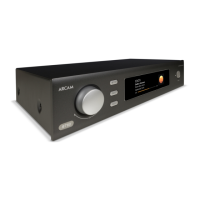EN-12
Theory of Operation
The ST60 contains three PCBs, the PSU, main digital
audio PCB, DAC PCB and the display PCB. What follows
is a detailed overview of each PCB as well as any signals
that go between the PCBs.
A note on standby modes
The ST60 has a number of dierent standby modes as
set by the Standby Settings menu.
Standby Mode Note
RS232 NET
OFF OFF Lowest power mode.
Network module disabled
no RS32 or IP control.
ON OFF Network module disabled.
RS232 control availble, no
IP control
ON ON Network module enabled.
RS232 and IP control
availble.
PSU PCB - L303
The ST60 runs on 5VDC with the other supplies being
generated loacally where required from this 5V rail.
The PSU PCBs sole purpose is to convert AC mains to 5V.
The AC live is isloated/switch by the front panel
mounted switch.
The live and neutral are connected to the XP VCE PSU
module which generates the 5VDC for the rest of the
unit.
5V and 0V is connected to the main digital PCB by a 6
way header CON2.
Digital PCB - L279
The digital PCB has 4 main components and functions:
• Host microcontroller (MCU).
• Network module.
• Digital audio output.
• Digital audio input.
Host MCU
The host MCU IC400 controls the various components
in the ST60 using dierent communications intefaces.
I2C to control the network module (MOD200).
I2C to control the DAC and SPDIF receiver (IC100).
SPI to control the SPDIF transmitter (IC102).
RS232 to control the front panel MCU.
The MCU is powered by 3.3V generated locally from the
5V rail by REG500.
Network module
The network (avatar) module is responsible for receiving
and generating the digital audio from the various
streaming services as well as from USB sticks.
The module is conencted to the network via wi or by
wired ethernet. Wi circuitry is contained within the
module itself. For wired ethernet the avatar controls an
external phy (IC204).
The audio is rendered by the avatar module in the I2S
format and is buered to the DAC and SPDIF transmitter
by IC200 and IC201.
The network module is powered via 5V which is turned
on/o by the host MCU using M500.
The I2S audio is sent to the DAC PCB via CON1
Digital Audio Output
The ST60 has both a coaxial and optical SPDIF output.
Both of which are generated by IC102.
IC102 is powered by 3.3V genetated by REG501.
NOTE: The digital and analogue audio are mutually
exclusive i.e only one type of output can be enabled
at any one time. The output type is set using the
Digital Output option in the Audio Settings Menu.
Digital Audio Input
The ST60 has a pair of coaxial and optical SPDIF inputs
all of which are received and converted to I2S via IC100.
The I2S audio is sent to the network audio module
which switches between streamed audio content and
the external SPDIF inputs.
IC100 is powered by the same 3.3V rail as the SPDIF
output.
DAC PCB - L301
The DAC (IC103) converts the I2S audio to analogue
audio which is output via the single ended RCA and
balanced XLR outputs.
The balanced outputs are fed directly from the IV stage
in the DAC lter (IC100 & IC104). These signals are
combined in the nal stage of the lter and converted
to single ended (IC102).
IC101 is used to set a mid rail DC reference level for the
analogue output.
The DAC has muliple 3.3V supplies all generated from
the main 5V rail.
The output lter runs on +/-5V. The -5V rail is generated
by a charge pump (IC201).
Display PCB - L302
The LCD display (DISP1) on the ST60 is a self contained
module that includes all the required drivers and local
power supplies.
It is powered via 5V and 3.3V. The power supplies are
generated by REG1 and M1 both of which are controlled
by the host MCU.
The display itself is controlled by a dedicated MCU
IC1. This MCU is responsible for sending data in order
draw the GUI. The information that is to be displayed
is supplied by the main host MCU via and RS232
connection.
The back light for the display is controlled by the main
host MCU with TR2.
The display MCU is powered by REG1
The front panel encoder, switches and LEDs are all
under the control of the main host MCU.

